
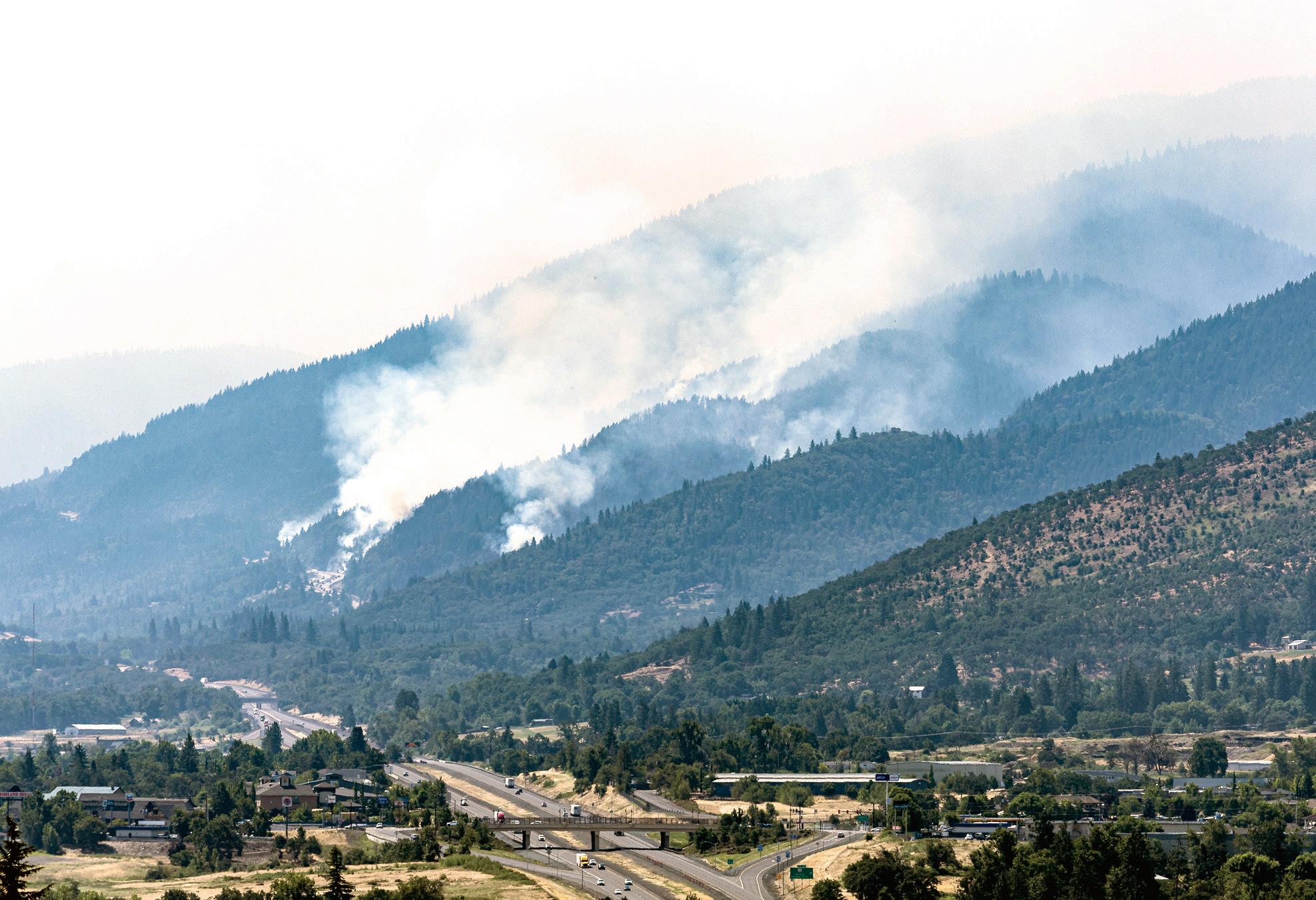
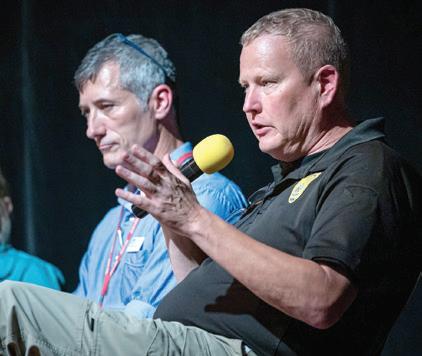
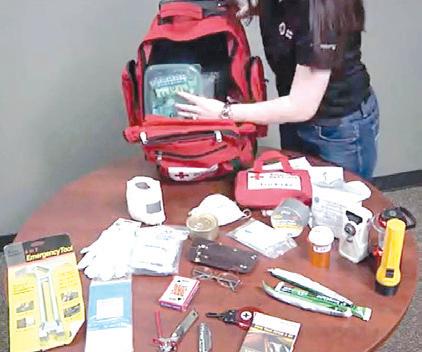













Ashland Chamber of Commerce & Ashland Fire & Rescue

For decades, the Ashland Chamber of Commerce has partnered with Ashland Fire & Rescue to champion wildfire prevention, smoke mitigation, and emergency preparedness.
Why? Because everything is connected—and protecting our environment means protecting our people, economy, and future.
We educate, advocate, and promote a stronger, more resilient economy and quality of life
We create scalable, actionable programs to support businesses, residents, and visitors
As we’ve seen from the Almeda Fire and years of wildfire smoke, the impact can be devastating— environmentally, economically, and socially.

Advocated for federal funding since 2000 for Ashland Watershed fire mitigation
Hosted regional fire summits & prevention forums
Developed Business Resiliency Workshops for smoke awareness & indoor air quality improvements
Created the comprehensive resource SmokeWiseAshland.org in partnership with Ashland Fire & Rescue (2018)
Produced QR-code flyers, tent cards, emergency prep materials, videos & toolkits
Developed a tool kit for Business Recovery and Resiliency
Featured info across platforms: AshlandChamber.com, TravelAshland.com, Ashland Visitor Guide, and Living & Doing Business Guide
Engaged local to federal leaders to drive policy and funding
Shared our model nationally with FEMA, Fire Adapted Communities, San Francisco Federal Reserve, & World Forestry Center



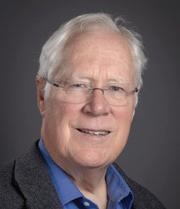



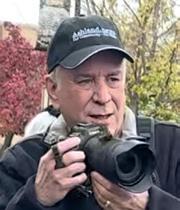

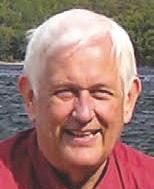




YMCA was the first to ask the city how to create a plan to safeguard staff and clients, including children; the Y’s CEO encourages other organizations to follow suit
to leave.......................... 17
Local, state and federal agencies will coordinate firefighter and police response; it’s up to residents to be prepared and help one another
the FAQs: How will you know when it’s time to go?
routes are available to get out
Hello neighbors! As president of the board of directors of Ashland.news, I’m thrilled to welcome you to this special print edition of Ashland.news dedicated to wildfire preparedness.
While many parts of the country have become news deserts, Ashland is fortunate to have a full-time news service. Ashland.news employs real-live professional journalists, under the leadership of our executive editor, Bert Etling, and we publish a host of talented community contributors.
Huge thanks to everyone who makes Ashland.news possible with your financial contributions large and small. We literally would not be here without your support!
To join the hundreds of Ashland residents who financially support the work of our nonprofit community newsroom, visit https://ashland.news/donation/ to make a one-time or recurring monthly donation.
While many of us long for “a newspaper that we can hold in our hands,” printing a newspaper would consume most of our budget. We have chosen to spend our money on high-quality journalism.



By Lorrie Kaplan Ashland.news president
As a nonprofit, mission-driven organization, Ashland.news also is committed to bringing our community together for our most important conversations.
And of all the issues that we need to be very informed on — that need to unite us and call us to our best selves — wildfire is right up at the top.
That’s why we took the lead last year to form a community collaboration with the city of Ashland, Ashland Fire & Rescue, Ashland Together, and the Ashland Climate Collaborative. Together, we hosted the 2025 Better Together Wildfire Series — a series of live and online programs.
This special print edition of Ashland.news captures and builds on the most important information developed through this teamwork. Very special thanks to Charisse Sydoriak, Hillary Larson, Kelly Burns, Chris Chambers, Dorinda Cottle, Tara Houston, and Brian Hendrix.
This publication was made possible with financial support from the Carpenter and Roundhouse foundations. Thank you for making it possible for us to provide this essential resource to every Ashland household.
Living in this beautiful Valley means living with wildfire risk. The good news is that we can greatly reduce that risk by working together to reduce flammable hazards in our midst, planning ahead, staying alert, and helping each other.
We hope this Ashland.news print edition is helpful to you as you prepare for the safety and well-being of your loved ones, friends, and neighbors.
Thank you for checking out this special wildfire print edition of Ashland.news! Your feedback will help us continue to improve our service to the community. Go online to bit.ly/WildfireEditionSurvey, or point your smartphone at the QR code which will connect you with a brief survey. Ashland.news thanks the Carpenter Foundation and the Roundhouse Foundation for their generous support that made this special print edition possible. Your survey responses helps let them know what impact their support has made.
‘What’s your plan?’ Ashlanders learn about evacuation readiness during interactive wildfire preparedness event

By Holly Dillemuth Ashland.news reporter
When a wildfire hits the city of Ashland and surrounding areas, what’s your evacuation plan?
An estimated 400 attendees packed the Historic Ashland Armory for a two-hour workshop Wednesday, July 16, to learn more about what to do to prepare should such a natural disaster occur in or near Ashland.
Attendees participated in a hypothetical wildfire scenario in south Ashland, took part in a Q&A session with panelists and mingled with vendors to learn how to sign up for evacuation notices and emergency alerts, register for Community Emergency Response Training (CERT) volunteer training, and prep food for natural disasters with Rogue Food Unites.
Ashland.news, Ashland Together, the city of Ashland, and the Ashland Climate Collaborative hosted the event, the fourth in a special series focused on community fire preparedness issues.
Panelists Ashland Chief of Police Tighe O’Meara, Emergency Management Coordinator Kelly Burns and Community Wildfire Protection Plan researcher Charisse Sydoriak shared their experiences and answered questions from the crowd following a presentation on wildfire preparedness, with Oregon Shakespeare Festival’s Tara Houston, also an Ashland.news volunteer, emceeing the event.
“We are not here to solve wildfire(s) tonight,” Houston said. “Our goal tonight, though, is to help give you resources so that you know where to look to help build your plan after leaving this room.”
Houston acknowledged that with smoke and high temperatures that have lingered in the Rogue Valley from surrounding fires in recent weeks, the forum was even more crucial for the community.
“This conversation is more real today than it ever has (been), with the
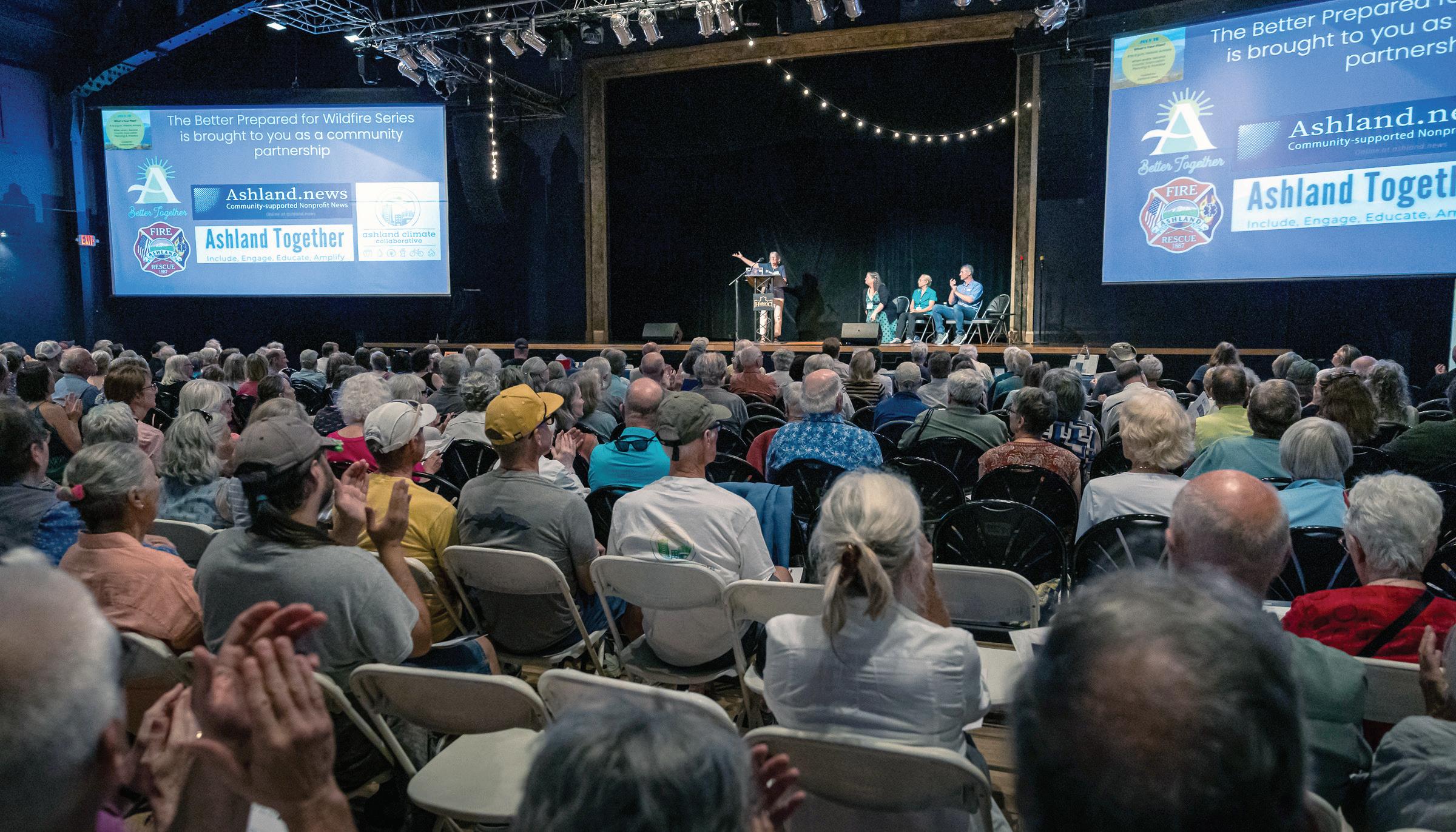
wildfires that ripped through L.A. in the winter, with the fires that started not far away from here with a lightning storm,” Houston said. “These dangers are in our backyard, so it’s really important that we come together as a community and find our path forward.”
“We’re going to give you a scenario that might scare you a little bit.”
Ashland
Emergency Management Coordinator Kelly Burns
Burns was among those who spoke to attendees about evacuation preparedness. A 32-year veteran firefighter and paramedic with Ashland Fire & Rescue, he has served in emergency management since 2023.
Burns invited residents to practice their own evacuation depending on where they live in the city while they are at home this summer.
“We’re going to give you a scenario that might scare you a little bit, but we’re all in this together and, as long as we work together, we’ve got a better chance.”
Then, attendees actually had the chance
to put a hypothetical evacuation into practice Wednesday evening, with people sitting close by. Residents talked amongst themselves about a hypothetical fire that started in south Ashland and moved toward the center of town, prompting, hypothetically, a citywide evacuation. They talked amongst themselves about what they would do and where they would go.
Selene Aitken, 78, was among those who participated in the simulation.
“I want to be prepared,” Aitken said, “and I think because it’s so scary that I need repetition …
“My nervous system kind of interferes with my learning.”
“We know what happened in Paradise (California), even the Almeda Fire,” she added. “I’m really glad they did this program.”
Aitken said she came to the event out
of concern for wildfire preparedness.
She was appreciative of how Houston navigated the emotions that can surround wildfire preparedness, including short breathing exercises that Houston facilitated for attendees twice during the two-hour event.
Aitken said she would tell others, “Keep preparing, keep thinking about your plan.
“I intend to look at all the possible ways to exit or sit it out (if not in the path of a fire),” Aitken said.
Burns emphasized that, while the scenario of having a wildfire in Ashland can be scary, it can empower residents to start making a hypothetical plan and to get to know the necessary resources, including evacuation routes.
“You don’t have to be fearless, but you can keep moving forward,” Burns said.
Burns explained that Ashland contains 10 zones that help discern evacuation areas during a disaster event such as a wildfire.
“You live in the Rogue Valley in Jackson County, and Jackson County decades ago was host to lots and lots of fires,” Burns said, “and you know what we are now? We’re host to lots and lots of fires, so you live in a place where you need to pay attention to the weather.”
Burns urged residents, commuters, and tourists to sign up for evacuation notices by texting the following to 888777:
• 97520: To receive local advisories on power and utility outages, missing persons, and emergency messages
• WATERSHED: For information on fuels-reduction burns in the Ashland watershed and smoke advisories and resources.
• 97520SHELTER: For warming, cooling, cleaner air center notifications.
• JACKSONEVACS: To receive evacuation notices for all of Jackson County.
For those who for some reason do not receive an alert, Burns noted that alerts should override the silent feature on iPhones, though not cellphones in airplane mode.
“Ultimately, if it’s a red flag warning period … if it’s like, weather right now, don’t keep your phone on silent,” Burns said. “It behooves you to sleep light and just be more ready.”
He also reviewed evacuation levels:
• Level 1: Be Ready!
This level encourages individuals to be aware of danger in the area and to check in with neighbors, family, and friends.
• Level 2: Be set!
Individuals are encouraged to pack up their go bags in their vehicle and, if they don’t have one, to make arrangements ahead of time in the event evacuation is needed.
• Level 3: Go Now!
Individuals under this level must evacuate, with no time to grab valuables.
“Don’t wait for us to say, “Go!” Burns reminded the audience.
Rogue Valley YMCA recently worked with Burns to create Level 1, 2, and 3 evacuation plans for the YMCA. Ashland School District also has a plan in the works, according to Burns.
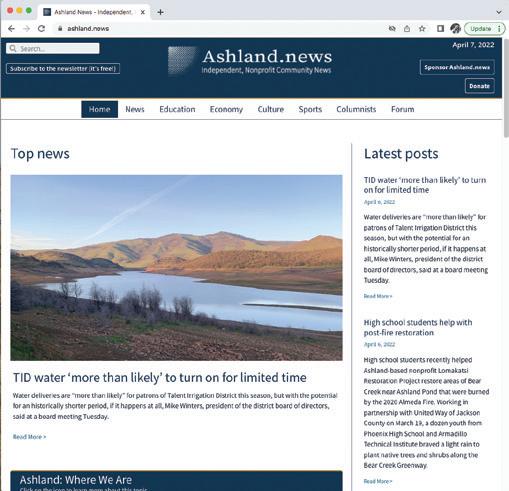
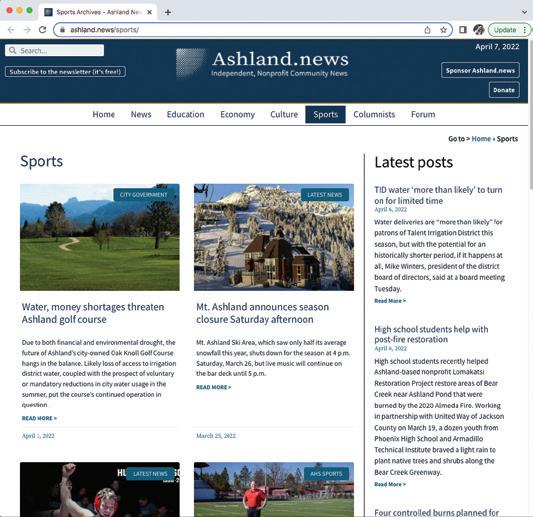
“I’ve been working with our administrative staff at the school district because I think my kids are near and dear to my heart, too, and I want them to have a plan,” Burns said.
“I know that our district is doing the framework of a Level 1, Level 2, Level 3 so that they have plans and destinations for kids,” he added.
Burns admitted that even those in emergency management don’t always have all the answers in regards to every case-by-case situation involved in evacuation. He encourages residents to be watchful of red flag and high wind warnings and to trust their gut if they feel the need to evacuate earlier.
Since the Almeda Fire, an on-ramp has been installed to the southbound lanes of Interstate 5 from North Mountain Avenue that’s accessible only with help from the Oregon Department of Transportation if the need for evacuations arises.
“I want more places that we can get out of town if we need it, so just know I’m pushing that, and I’m doing my very best,” he said.
Sydoriak noted that those living outside of North Mountain Avenue should not count on that ramp, as it likely could be congested during an evacuation.
“The evacuation study showed that it only shortened the evacuation time from the city, which is four hours, by 10 minutes,” she said, drawing gasps from the crowd.
Burns noted that planning your routes ahead with various exits out of town can help prepare you and your family.
Burns also emphasized the need for a go bag, however simple, and noted that some have developed “go bag shame” after hearing the advice over and over, but still have not taken any action.
Aitken has had a go bag ready for the past two years. She has lived in Ashland since 1985 and currently lives in the Railroad District.
Asked what’s in the bag, she said, “Too much, I think.”
From cash to a change of clothes, a toothbrush, toothpaste and a water bottle, her bag is ready should the day come.
continued on page 23
For tips on preparing a go bag, go to: ready.gov/kit
To find out what evacuation zone you live in, go to: ashlandoregon.gov/962/Know-YourEvacuation-Zone
To learn more about Community Emergency Response Team (CERT), goto: ashlandoregon.gov/212/CERT-YourCommunity-Emergency-Response-T
To watch a video of the ‘What’s Your Plan?’ forum, scan QR code or go to: bit.ly/4ofc14a

When: Aug. 21
Where: An online “Zoominar” on the western states wildfire-driven home insurance crisis and a new home certification program that might help people keep their insurance. Details will be posted in the Ashland.news calendar as they become available (ashland.news/events/)
When:
Friday, Sept. 26, 5:30 p.m. to 8:30 p.m. Saturday, Sept. 27, 8 a.m. to 5 p.m. Friday, Oct. 3, 5:30 p.m. to 8:30 p.m. Saturday, Oct. 4, 9 a.m. to 5 p.m.
Where: SOU’s Lithia Motors Pavilion, 1465 Webster St., Ashland
When: Saturday, Oct. 11, 9:30 a.m. to 11:30 a.m. Where: To be announced





By Meg Wade For Ashland.news
The 2002 Hayman Fire near Colorado Springs started in the mountains. It was miles away from Paul and Nyshie Seymour’s home north of the city, in a development on annexed land. The warning level was only at Level 1: Get set. For four days, that’s where it stayed.
Then the winds changed.
Paul wasn’t at home that day. Nyshie was.
“She called me and said, I can see the flames coming over the mountains. And I said, you need to leave, and get out of there,” Seymour recollects. “And she said, OK, as soon as I find the cat, I’ll go.”
He discouraged her from searching for the cat, but Nyshie insisted. It cost her time. The cat couldn’t be found. At last she found it hiding under the bed.
She called her husband back 15 minutes later to report that she was on the road. But there was just one road to take out of Woodmen Valley, and it went toward the fire.
Seymour recalls: “She said to me, the smoke is thick, I can’t see the roads, I see flames everywhere. I don’t know what to do. I’m just going to drive and hope I can stay on the road.
“And then our cell phones went dead.”
With only one route in and out, Seymour couldn’t go look for his wife. Traffic in the area was already at a standstill.
But in their preparations for the fire they had set a rendezvous point, at the home of Paul’s sister. Eight miles away, they had already taken some of their belongings there when evacuation warnings were first announced. He headed there. He doesn’t remember how long it took Nyshie to arrive, only that she did.
Today, Seymour emphasizes the importance of that set meeting place.
“That was real important for us, because otherwise I wouldn’t know where she was, I wouldn’t know if she was safe, she wouldn’t know where I was.”
The Hayman Fire ultimately burned 137,760 acres. It remains the fourth largest fire in Colorado’s history. But the Seymours were lucky; crews stopped the fire’s progress and their home was spared.
Seymour still remembers the process of going through the house after the initial evacuation warning.
“We went through the house and said, OK, what do we want to take? What’s important?”
Artworks, papers, photographs and musical instruments made the cut.
“We took things that had memories. We didn’t really

think about the financial value of things. We said, that’s just stuff we bought. It doesn’t have an attachment to our heart and soul.”
“We got everything we really cared about in one pickup truck.… That was an emotional experience, to say, here is what really matters in terms of our possessions. Everything else could be replaced.”
Seymour relocated to Ashland a decade ago, to be near one of his children after Nyshie’s death from cancer. He says he didn’t worry much about moving to another fire-prone area.
“Part of that is, where are you going to go? You go to the Midwest and you get hurricanes, tornadoes.… There’s just kind of no place to go. So you pick your natural disaster and that’s where you live.”
He feels that his experience in Colorado Springs helped him build resilience to face future disasters. That includes seeing their preparations, like setting a meetup destination, work out as planned. But the process of going through his house and learning what really mattered was also influential.
As a former psychologist and organizational consultant, Paul thinks often about questions of resilience, both personal and collective.
So how does he think those in Ashland can improve their resilience?
First is learning to trust that you can make it through such an event. And learning to manage anxieties about the future so that they aren’t overwhelming.
Knowing who you can count on, even if they don’t live in the same place, is also key.
“Who’s your support system? Who do you love? Who loves you? Who are the people that really matter to you?”
If you don’t already have such support, going to local


Nyshie and Paul Seymour (left). Not knowing where their cat Logan (right) was delayed evacuation, making an already perilous situation even more dangerous. — Courtesy photos
events, taking part in groups, can help create connections.
“It’s finding a community of people,” he says.
He also emphasizes not making rash decisions, “especially around money.” He remembers a friend in Colorado who drove back through the fire to retrieve a diamond necklace.
“She put money in front of her life. She had always kind of lived like money and those things were the most important. And I think you have to get clear that they’re not.”
Most of all, Seymour says, is “getting clear about what’s important to you in life and trying to live your life that way.”
That, he says, is what helps one to know that “Yes, we can lose it all, and we can rebuild.”
Email Ashland resident and freelance journalist Meg Wade at news@megwade.net.
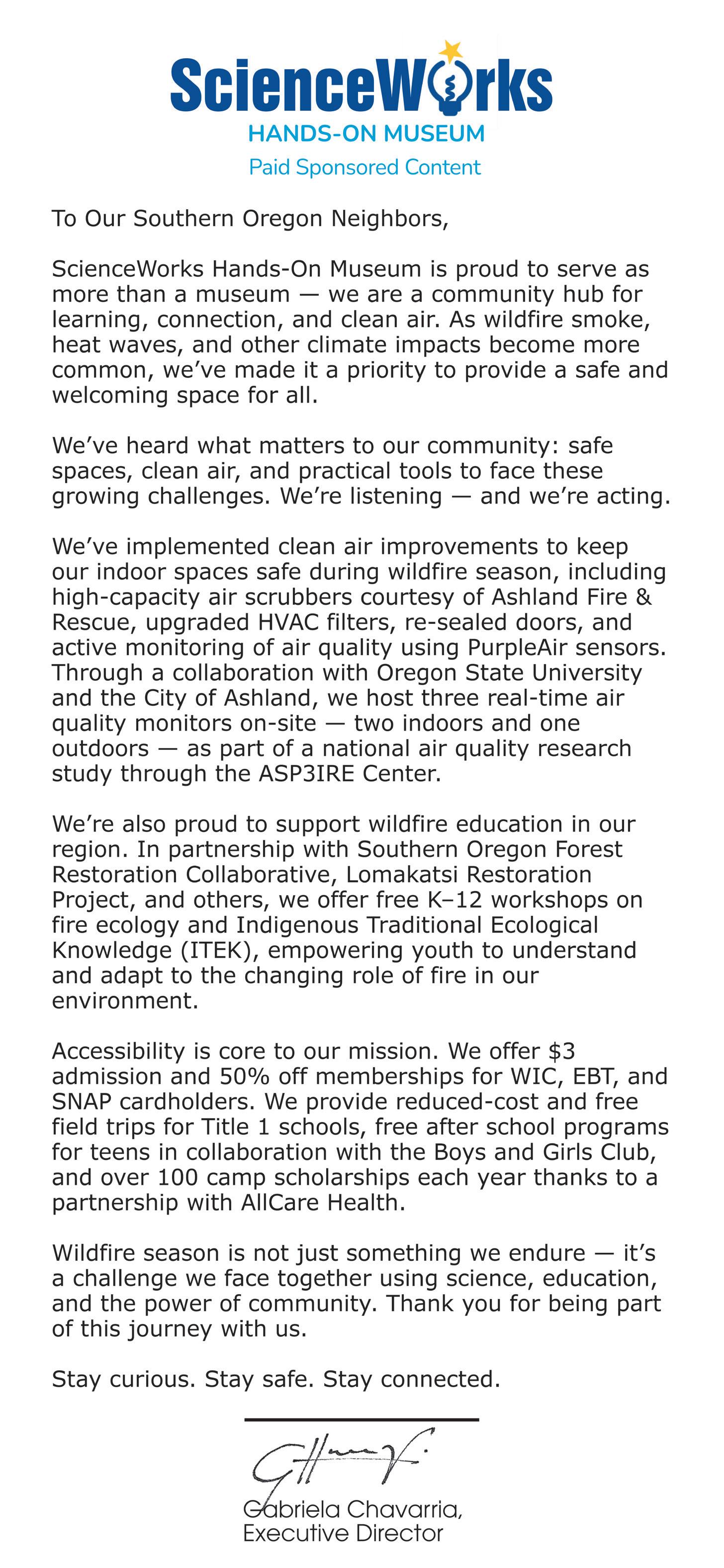
Pacific Power changes settings during periods of ‘elevated fire risk’
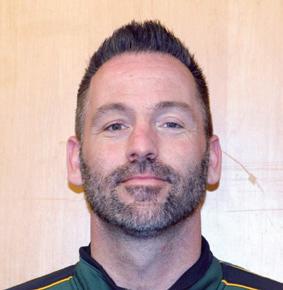
OBy Steve Mitchell For Ashland.news
ver the period of about a month this summer, nearly 1,500 people living on the south end of Ashland have lost power three times because of wildfire safety settings aimed at preventing fires on equipment owned by Pacific Power.
Thomas McBartlett, director of the city’s Electric Department, said in July that the longest outage lasted about six hours; the others lasted about an hour.
The city of Ashland Electric Department services customers within city limits, delivering power primarily purchased from the Bonneville Power Administration and delivered to Ashland over Pacific Power transmission lines. The outages affecting some city of Ashland customers were due to shut-offs on Pacific Power equipment so, even though it was their customers affected, the city department was not able to work on the cause of the outage.
Simon Gutierrez, a public information representative with Pacific Power, said the utility company implements its enhanced safety settings in areas where the company’s meteorologists have deemed an area as being in a period of “elevated fire risk,” arising when there is a combination of dry fuels and other conditions that the meteorologists are monitoring.
When the enhanced safety settings are in play, Gutierrez said, the aim is to prevent sparks from igniting a fire. He said the settings are so sensitive that a branch, a bird, or even debris coming into contact with a power line can prompt an outage in “fractions of a second.”
According to Pacific Power’s website (pacificpower.net), the safety settings are an extra precaution the utility company takes to prevent wildfires. The Pacific Power website notes that crews must
patrol an area where the settings have prompted an outage before power is restored.
City of Ashland employees are not allowed to restore power to equipment or power lines controlled by Pacific Power, McBartlett said. He said Pacific Power ground crews must get authorization to restore power to an area when the safety settings are tripped.
Gutierrez said those customers in an area the utility company has identified as being in danger of wildfire receive an email notification of the likelihood of an outage.
McBartlett said the Pacific Power’s fire settings are affecting people only on the south end of Ashland. Ashland Electric, the city-owned utility provider, has more than 10,000 customers on its grid.
Gutierrez said Pacific Power is exploring installing electrical equipment that would allow Ashland more control when Pacific Power’s fire settings shut down entire power lines.
He declined to offer specifics of when Pacific Power might decide whether it would move forward on purchasing or installing the equipment.
McBartlett said such equipment would be purchased solely by Pacific Power and that the city would not have bear any of the cost.
“We have been working with Pacific Power at all levels to try and reduce outages for both utilities,” McBartlett said. “When there is an outage we have open lines of communication with them to work together on restoration.”
McBartlett said Ashland’s grid is in “good shape.” He said the system is reliable.
“We have a really good history and high reliability,” he said. Of the recent outages in south Ashland, he said, “This is kind of a one-off, odd situation for us.”
Email Ashland.news associate editor Steve Mitchell at stevem@ashland.news.
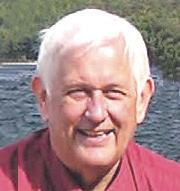
By Jim Flint
For Ashland.news
When disaster strikes, seconds matter — and in Southern Oregon, residents know too well how fast things can go from calm to chaos.
From wildfires that blackened skies with smoke to the 2020 inferno that destroyed more than 2,800 structures between Ashland, Talent and Phoenix, the region has seen firsthand the value of being ready to evacuate at a moment’s notice.
That’s why local emergency volunteers like Paul Collins, a longtime member of Ashland’s Community Emergency Response Team, urge every household to pack a “go bag” — a kit of essentials you can grab in an instant when the order to “Go Now” arrives, possibly with just a knock at the door and flames nearby.
A call to serve
Collins, a 17-year Ashland resident and a senior software engineer at DigitalFish, where he works on tools for 3D and 2D content, joined CERT to give back to the community he calls home.
“I was thinking I should do something to help out around here,” he said. He joined the organization after seeing an ad for CERT training.
“That training was so much fun,” he said, “being on a team doing simulated emergency search and rescue. I was hooked. Since then, there’s always been so much more to learn, practice and do.”
Collins and his family have personally experienced a wildfire evacuation. It was a Level 2 condition, so they had a couple hours to choose what to take with them. When it’s a Level 3 order, there is little to no time to plan and pack.
“I advise people to use a generic checklist as a guide to making a go bag list for themselves,” Collins said. To see a suggested checklist from the American Red Cross and view a video about building a go bag, visit projectwildfire.org/kit.

This image is from an American Red Cross video that shows how to pack a go bag. View the video and see a go bag checklist at projectwildfire.org/kit.
In an interview, Collins shared his insights on go bag priorities, how to make evacuation plans, and why even a deck of cards can make a difference in a crisis. Responses have been edited for clarity and length.
Ashland.news: What are the most essential items everyone should include in a basic go bag?
Collins: Prescription medicines, extra cash in small bills, toothbrush, some readyto-eat food — think protein — overnight stuff, flashlight and an AM radio.
AN: Are there different go bag recommendations for individuals versus families?
Collins: Sure, and different families and folks will have different priorities. Don’t forget unpowered entertainment — like a deck of cards or a board game. They can help reduce stress and provide some distraction.
AN: How much food and water should a person pack, and what kind is best?
Collins: The general guideline is one gallon of water per person per day, and we encourage people to be “two weeks ready.” Of course, that’s more than you’d take in a go bag, so decide what’s practical to bring if you need to evacuate quickly.
AN: What special considerations should people make for children, seniors or pets when packing a go bag?
Collins: Most checklist guidelines suggest medical supplies such as hearing

aid batteries, glasses and syringes; baby formula and diapers for the little ones; and pet supplies such as food, leashes, collars and a bowl.
AN: How often should you check or update the contents of your go bag?
Collins: At least at the beginning of fire season, and as often as needed to rotate food.
AN: What are some common mistakes people make when preparing their emergency kit?
Collins: You don’t need to put together a perfect, fully stocked go bag right away. Start with a few essentials so you have something ready. Just as important, make a plan for both evacuation and shelter-in-place situations.
AN: Where should you store your go bag so it’s easily accessible in an emergency?
Collins: Think about where you’d likely exit your home and what you could actually reach after an earthquake. Also, keep a pair of shoes and a flashlight under everyone’s bed — they can be essential if you need to move quickly in the dark or around debris.
AN: How does having a go bag fit into a broader family or community emergency preparedness plan?
Collins: A go bag is even more effective when paired with a practiced family emergency plan. Know your community’s needs, prepare yourself first and you’ll be better able to help others in a disaster.
Freelance writer Jim Flint is a retired newspaper publisher and editor. Email him at jimflint.ashland@yahoo.com.
Ashland YMCA was the first to ask the city how to create a plan to safeguard staff and clients, including children; the Y’s CEO encourages other organizations to follow suit
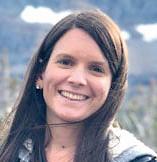
TBy Holly Dillemuth Ashland.news reporter
he Ashland Family YMCA has always had an internal safety plan, says Heidi Hill, chief executive of the organization. But not until last fall did the nonprofit have a specific plan for a wildfire evacuation on the books. It is the first local organization to ask Ashland Emergency Management Coordinator Kelly Burns how to make such a plan.
Hill and her leadership team came together late last year to talk through the issue. They decided to take a thoughtful approach to how the nonprofit would handle a serious evacuation strategy.
“I was embarrassed that we didn’t have one because people entrust their children to us, and not only that, but we serve as a community center,” Hill said.
“This place is very meaningful to a lot of people and,” she said. “It’s a safe place for them. “It really was time for us, I felt, to focus on a wildfire evacuation plan.”
Burns surprised Hill when he told her she was the first to ask him about one.
“We’ve been approached by other businesses, but not about evacuation plans,” Burns told Ashland.news in a separate interview.
How long it takes to create an evacuation plan depends on an organization’s size, capacity and attention span, Burns said.
“They need the plan now, they needed it yesterday,” he said.
“I think individually, as well as organizations, it’s something that needs to be taken seriously and just needs to become part of the normal fabric of what you do as you do business here in the valley.”
Burns praised the Ashland Chamber of Commerce for leading the charge when it comes to emergency preparedness for businesses in general.
“They have an emergency preparedness tool kit that they designed that’s available for free,” Burns said.
Burns emphasized that making an evacuation plan is just the first step. The next is to prepare to be ready when things don’t go as planned.
“You should be ready to adapt and change gears and make good decisions in the moment,” Burns said.
In July the YMCA had a chance to put its evacuation plan into action with the Neil Creek Fire, one of more than 50 fires sparked by lightning.
“That actually gave us (an) opportunity to practice our own plan,” Hill said.

Hill recalls staff waking up at 4 a.m. many days to see where the zones were in terms of evacuation levels.
“If the evacuation zones next to us were at a Level 2, we wouldn’t be opening the Y,” she said.
“That is to enable parents to pick up their kids,” she said, and “to exit our primary facility and go to their respective homes and get ready, get set themselves.
“We would open our extending sites, but we weren’t opening the Y,” she said. “And so, every day, it kind of gave us an insight into at least monitoring and communicating with our parents and our members about what we’re doing for safety.”
Hill encourages individuals and organizations to prepare a plan before it is needed.
She found that although the process to create an evacuation can seem intimidating at first, “It also just requires a layer of common sense, discussions that are better had ahead of time than in the moment.”
Hill said the Ashland YMCA drew on some draft wildfire evacuation plans from other YMCA camps throughout the country, then focusing on customizing the plan to Ashland and its Y members. She said the nonprofit also drew on the expertise of Burns. An internal audit was taken of assets for communication and to determine where the Y would have people located. The Y “developed a plan from there,” Hill said.
On any given weekday, Hill said, the Ashland YMCA could have about 550 people at its YMCA Way facility, including day camp kids, Hill said.
The nonprofit also has three off-site locations — Helman, Walker, and Talent elementary schools — with a total of 60 students, plus an additional 15 staff working just within the Rogue Valley, Hill said.
The Ashland Chamber of Commerce is leading the charge when it comes to emergency preparedness for businesses.
YMCA continued from page 10
“This doesn’t count the additional 150 kids or more that we have at Camp DeBoer” at Lake of the Woods, she said.
“Our plan really focused on, where is the risk?” she said. “Where are our programs located and in what zones? How do we work with the existing evacuation protocols, like Level 1, Level 2, Level 3.”
Identifying how to transport youths and staff members is another key part of the YMCA making a plan.
“We have a small fleet of cars but not nearly enough for everyone,” Hill said.
She said the Y has a positive relationship with the Ashland School District. But in the event of a wildfire evacuation, she said, it isn’t clear what transportation resources would be available to the Y from the district.
“We have to rely on our families and our members being responsible and responsive, too, if there is an evacuation,” Hill said.
Hill said the Y does have access to two buses that are kept at Camp DeBoer during the summer months.
“That is their evacuation strategy,” she said.
For more information about creating an evacuation plan, contact Burns at 541-552-2299. For those interested in learning about a free tool kit for emergency preparedness for businesses, contact the Ashland Chamber of Commerce at 541-482-3486.
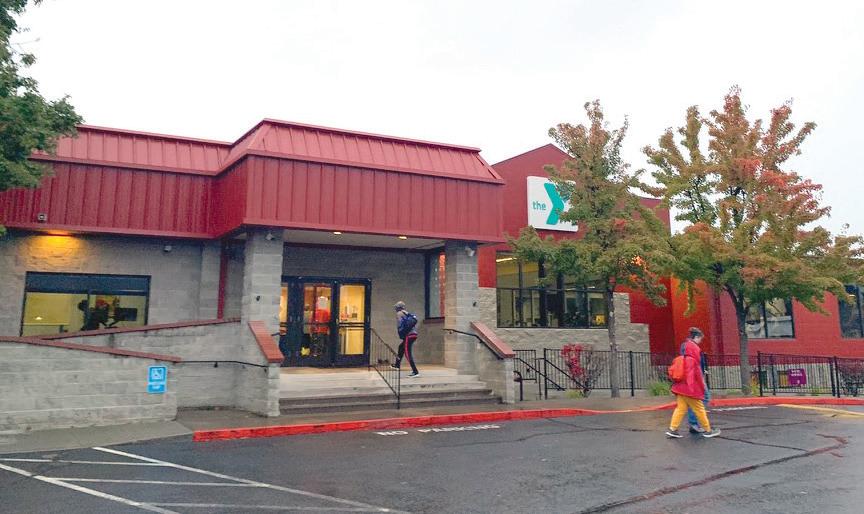
Based on where a fire were located, the YMCA has identified three possible evacuation destinations if staff had to evacuate with children, Hill said: a Fred Meyer store in Medford, All Star Liquors in Hornbrook, California, and the Grants Pass YMCA.
“We had to identify where would we convene,” she said.
Hill encouraged YMCA members and nonmembers to sign up for the Ashland Y’s text messages by texting AFYMCA to 54539.
“We only use texts for communications about facilities or emergencies or closures,” she said.
Hill said there has been a good response to the text program, with about 2,000 to 3,000 of its 9,000 members signed up.
“At first people were very hesitant to sign up, but that’s become less and less,” she said.
Hill, who came to the Y in fall of 2022, is no stranger to emergency management. She was exposed to emergency management training while working in the offices of the mayor and city manager of Medford. But that level of experience isn’t necessary to get started on a plan.
need to know what the wildfire or emergency plan is. Then they need to know “what their role is in it.”
“That’s really our next hurdle,” said. “Now that we have the plan, how do we
enculturate the plan so that everybody knows what our protocols are?”
Reach Ashland.news reporter Holly Dillemuth at hollyd@ashland.news.


“I think it’s a challenge for organizations to train the ... multiple layers of staff,” she said. First, staffers
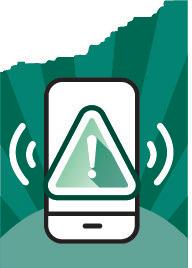
The City of Ashland partners with Jackson County to use a shared alert messaging system, providing real-time notifications to residents during local emergencies. You’re encouraged to create an account with JACKSON Alerts—this will ensure you receive emergency alerts from both the City of Ashland and Jackson County.
Prefer not to create an online account or only want Ashland alerts? You can still stay informed! Sign up for Ashland-only alerts via text—it’s quick and easy: Text 97520 to 888777.


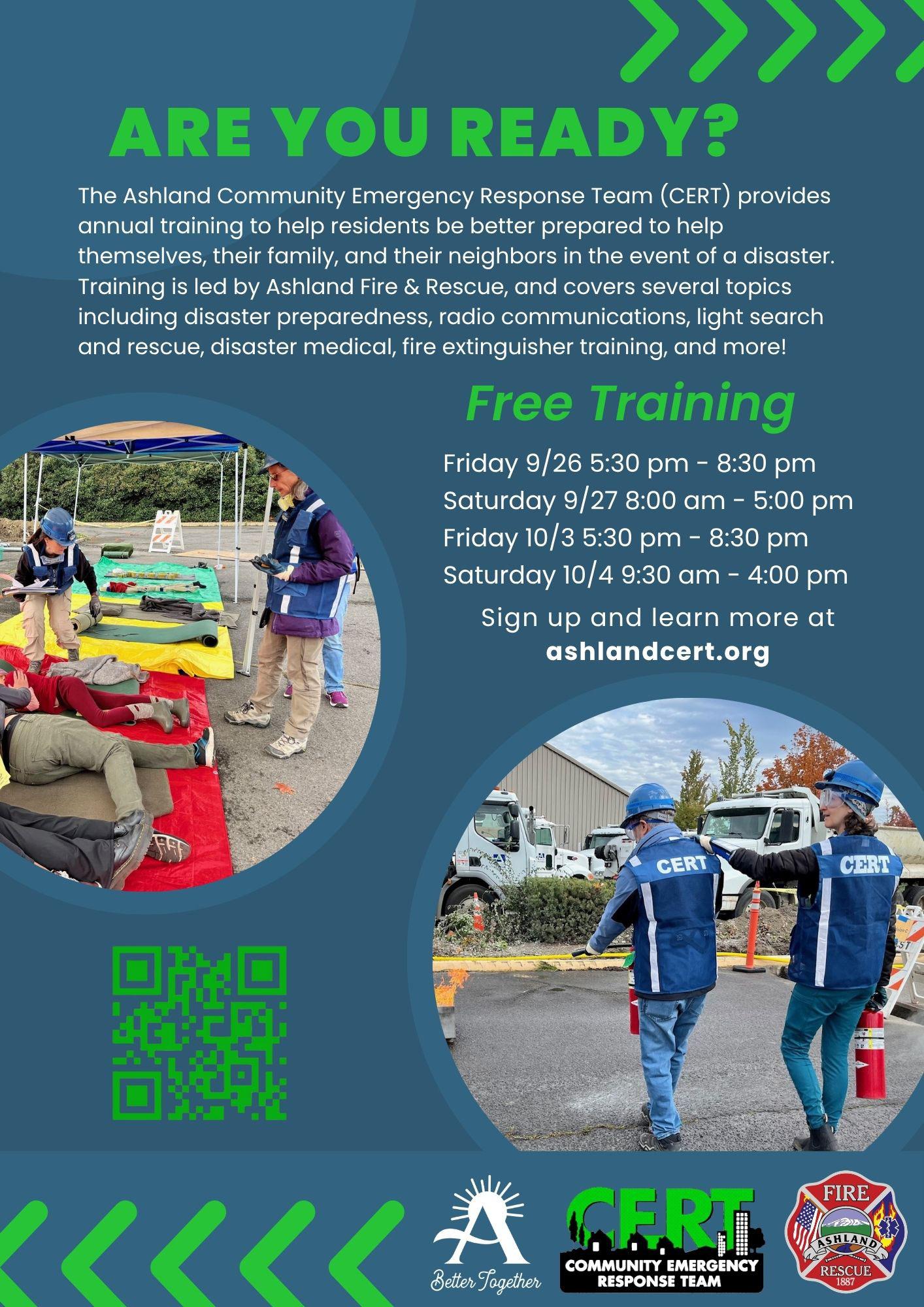

Stay informed. Check city, county, emergency service websites, and trusted sources for updates. Keep your cell phone charged. Have an emergency plan and go-kit ready with supplies for health, safety and identification. Inform loved ones of your plans. Designate a safe meeting place and out-of-area contact person for family members.
Gather important items such as documents, eyeglasses, medications, medical devices, food and plenty of water.
Act early if you are older or have children, disabilities or limited access to transportation.
Locate your pets and keep them with you. Consider evacuating livestock early.
Plan possible evacuation routes. If you do not drive, make other arrangements for transportation in advance.
Check with your neighbors if you have time and can do so safely. Exchange information. Ask for help if you need it and offer help if you can give it.
Don’t wait to evacuate if you need extra time to leave or if you feel unsafe. Conditions can change rapidly.
Critical: Prescription meds, medical devices, eyeglasses, food and plenty of water.
Safety: Sanitation items, first-aid kit, flashlight with extra batteries, gloves, eye protection, and face coverings or N95 masks. Wear long sleeves, long pants, sturdy shoes and a hat.
Communication: Phones, tablets, laptops, charging cords, hard drives or backup disks, maps and AM/FM radio. Consider making a list of important phone numbers before an emergency.
Documentation: Photo ID, driver’s license, birth certificate, social security card, passport, visa, insurance policy, mortgage deed or rental agreement, banking or financial records, etc.
Personal: ATM debit and credit cards, cash, clothing, hygiene items, family photos and other irreplaceable belongings.
Animals: Extra water, food, leashes, carriers, meds, identification, bedding, and medical records.
Visit Ready.gov for more information about being prepared for an emergency, including a full list of emergency supplies.
The new focus shifts away from fire-adapted forests to involving residents in hardening homes and neighborhoods against fire

By Sydney Seymour For Ashland.news
Two decades after it last adopted a wildfire protection plan, the Ashland City Council is expected to consider whether to approve a vastly revised plan on Aug. 19.
As wildfires increasingly devastate urban centers and threaten the loss of entire towns — like Lahaina, Hawaii, Paradise, California, and, of course, the 2020 Almeda Fire — Ashland’s focus for wildfire protection has shifted.
The city’s 2004 Community Wildfire Protection Plan (CWPP) emphasized wildlands and fire-adapted forests. Moving away from that, Ashland’s nearly 400-page 2025 CWPP prioritizes community engagement and urban preservation.
To bring Ashland down from the top 3% of communities in the U.S. at risk from wildfire, the area must become “a fuel break — not a fuel source,” the plan says.
Only 15% of homes currently meet wildfire-resistant construction standards in Ashland, the plan states. To meet the plan’s goal of 90% wildfire-resistant properties by 2036, it estimates it will cost about $8 million a year, split among the city, community groups and property owners over 10 years, with the expectation some funding will come from state, federal and private foundation sources in the form of grants or matching fudning.
In addition to sustained funding, meaningful progress requires community buy-in, a coordinating body and a trained workforce.
“There’s nobody in Ashland that doesn’t have a role in this,” Chris Chambers, Ashland Fire & Rescue’s forestry officer, said.
Taking into account an overextended city staff and the overwhelming task of
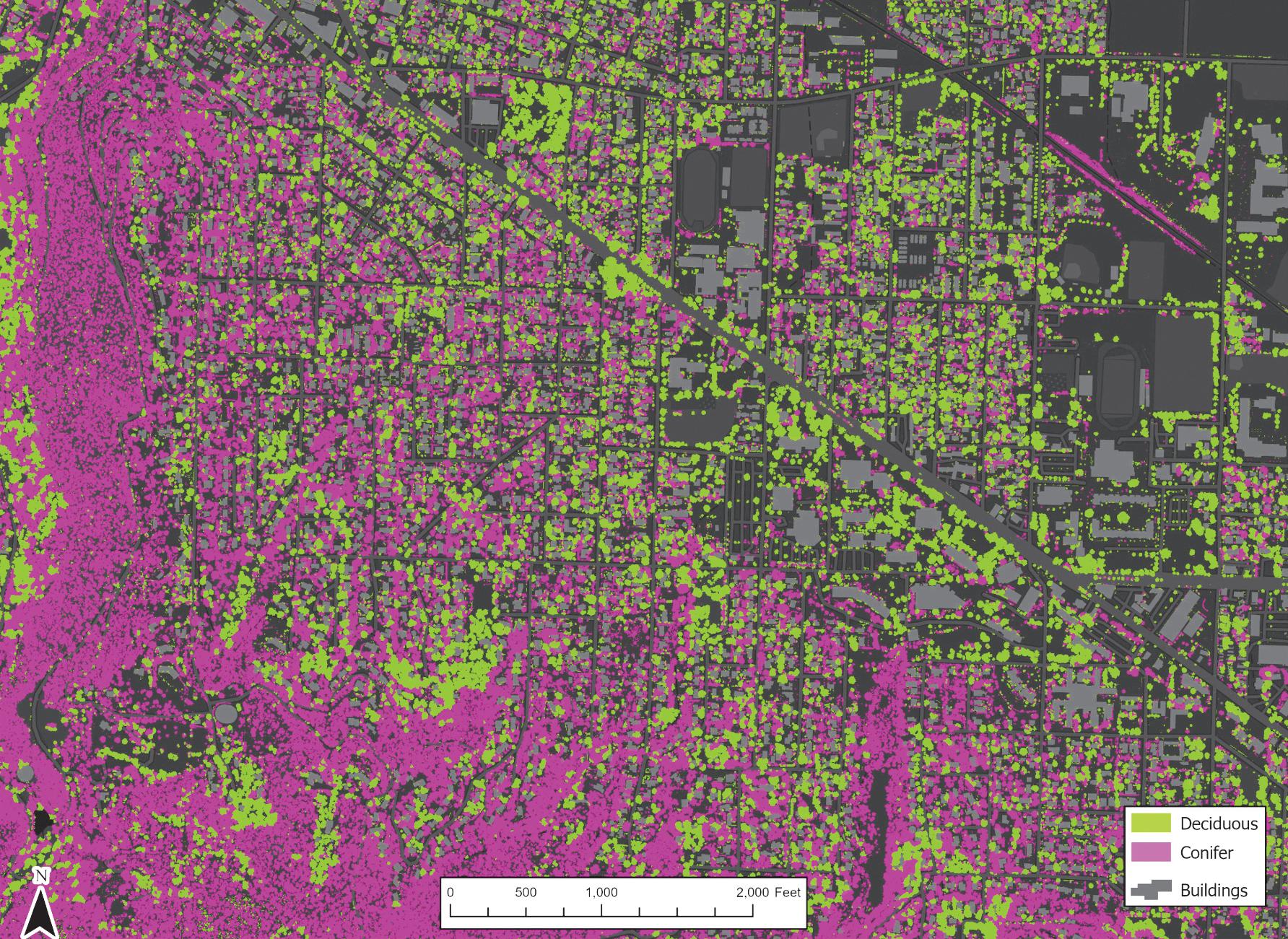
preparing communities for an extreme wildfire, it will be a collective effort. Businesses, nonprofits, educational institutions and individual residents in Ashland and the surrounding areas will have to take part in the efforts to preserve the community against the threat of catastrophic wildfire.
The plan calls for a “paradigm shift” from reactive response and individual voluntary compliance to proactive and accountable actions that prioritize longterm resilience and shared responsibility, whether you live right next to town or out in the woods.
“We just can’t keep doing business as usual,” Chambers said. “We need a massive project to give our town a facelift
and educate people to be ready for the next Almeda Fire day coming in the future.”
Chambers said that more than 100 individuals from various organizations in the Southern Oregon region provided advice in creating the plan, surveys of residents informed it and public comments helped in revising it. Thus, he said, the 2025 CWPP is “not meant to be a plan from the city government, but a plan from the community.”
The plan “pushes the boundary” on community engagement, which is vital in terms of reducing wildfire risk for urban configurations, said wildfire risk
assessment volunteer Charrise Sydoriak, who became the lead researcher and author of the 2025 plan.
“Community members are the key to all of this,” Sydoriak said. “They’re the ones that need to drive the process — not the city — and figure out how to make themselves and their homes more fireresilient.
“This isn’t all Ashland-focused, but we are collectively, as a coordinating body, sharing similar information across municipalities, which wasn’t happening before. The development of the CWPP and demonstrating that we can partner has been a big win here.”
Chambers explained that Ashland doesn’t have the capacity to respond with only its resources, which is why they are working with departments across Jackson and Josephine counties.
“We’re starting to knit together pieces of the landscape into cohesive areas where we have a better opportunity to manage wildfire,” Chambers said. “All the way from the Siskiyou summit to Jacksonville is now stitched together with fuel reduction projects. We’re really wanting to accelerate that work and the big limiting factor is just funding.”
The Community Wildfire Protection Plan has 44 challenge statements and over 220 initiatives, Chambers said. He added: “It’s not going to be cheap, and it’s not going to happen overnight.”
The only money currently available is from the city government’s wildfire risk reduction fee, which, starting July 1, increased to $7 from $3 per month added on Ashland residents’ water bills to support wildfire mitigation efforts. The fee will increase every year based on inflation.
Chambers said the fee is projected to generate $1.9 million over the next two years. That is expected to cover the staff expenses of the city’s Wildfire and Community Risk Reduction Division for two years, support forest management projects to reduce wildfire risk and fund protection plan priorities.
If the plan is adopted by the City Council on Aug. 19, the next steps are to apply for external funding, create a plan for spending and build partnerships to ensure implementation of the plan.
The plan’s team is currently forming budget proposals and spending outlines, prioritizing critical resources the community “can’t afford to lose because it will make recovery that much more difficult,” Chambers said. Those are outlined in the plan as high-value resources and assets, and include schools, the hospital, and cell towers.
By the end of 2025, the team hopes to assess opportunities for funding sources outside of the city government’s fee, such as state and federal grants. And it plans to establish a working group of funding partners to implement the plan.
Sydoriak emphasized the importance of developing a Fire Safe Council or another coordinating body to keep the plan alive. She spoke of revising the plan annually to ensure actions remain relevant and efficient, something the city has not done in the past, she said.
Unlike the 2004 plan, which briefly mentions singlefamily households, the 2025 CWPP aims to provide equitable access to wildfire services and resources — specifically for renters, who make up nearly half of Ashland’s community and have little control over property-level wildfire risk, and socially vulnerable populations who may lack access to information about wildfire preparedness.

The socially vulnerable include low-income individuals, those experiencing housing insecurity, people with disabilities, single parents, residents of multifamily homes and limited-English-speaking households.
To ensure better communication and improved strategies on how those groups can prepare for wildfire, the CWPP includes preparedness initiatives rooted in research that surveyed where members of vulnerable residents and renters in the Ashland area stand in regard to wildfire safety, preparedness and recovery.
“We really have to meet them where they are,” Chambers said. The CWPP team, he said, hopes to host events in places those groups frequent and build partnerships to help overcome distrust of government.
“If we understood their voice,” Sydoriak said, “we might be able to help them become better prepared for a life of wildfire.”
In addition to the continuation of automatic smoke detection cameras and regular drone flights with infrared cameras to look for fire starts, the 2025 CWPP especially invests in the use of lidar, or light detection and ranging, which utilizes aerial devices to strategically identify where disastrous fires are most likely to start.
By using lidar, Ashland Fire & Rescue has constructed 3D models of the landscape to analyze vegetation and topography, specifically areas of the city that have the highest risk of fire because of dense vegetation near structures and power lines. Firefighters look at vegetation density along evacuation routes so they can reduce vegetation with a high risk of wildfire.
“We’re just at the tip of the iceberg as to what we can do with lidar,” Chambers said. “We’re really trying to leverage that technology and data in a way that I don’t think any other community has done for wildfire risk.”
Email Ashland.news Snowden intern Sydney Seymour at sydneyseymourr@gmail.com.
A community’s strategic plan to avoid a wildfire disaster, a tool to understand where to prioritize city spending, and a key to unlock grant programs. Thousands of communities have developed CWPPs across the U.S. since Congress passed the Healthy Forest Restoration Act (HFRA) in 2003. HFRA requires CWPPs to be collaborative, include prioritization of fuel treatments, and recommend measures to reduce structure ignitions in a community, according to Fire Adapted Communities.
To read the 306-page draft CWPP: go online to bit.ly/4mDL2h5
To read survey findings in Appendix E of Ashland’s 2025 CWPP: go online to bit.ly/476RMPL
To view the CWPP highlights in a visual story map: go online to bit.ly/4l4i8W2
Links to emergency information for unincorporated areas of Jackson County, including an evacuation zone map, are online at: bit.ly/jacoevacmap
Emergency preparedness information for the city of Talent, including an evacuation zone map, is online at: bit.ly/talentevacmap
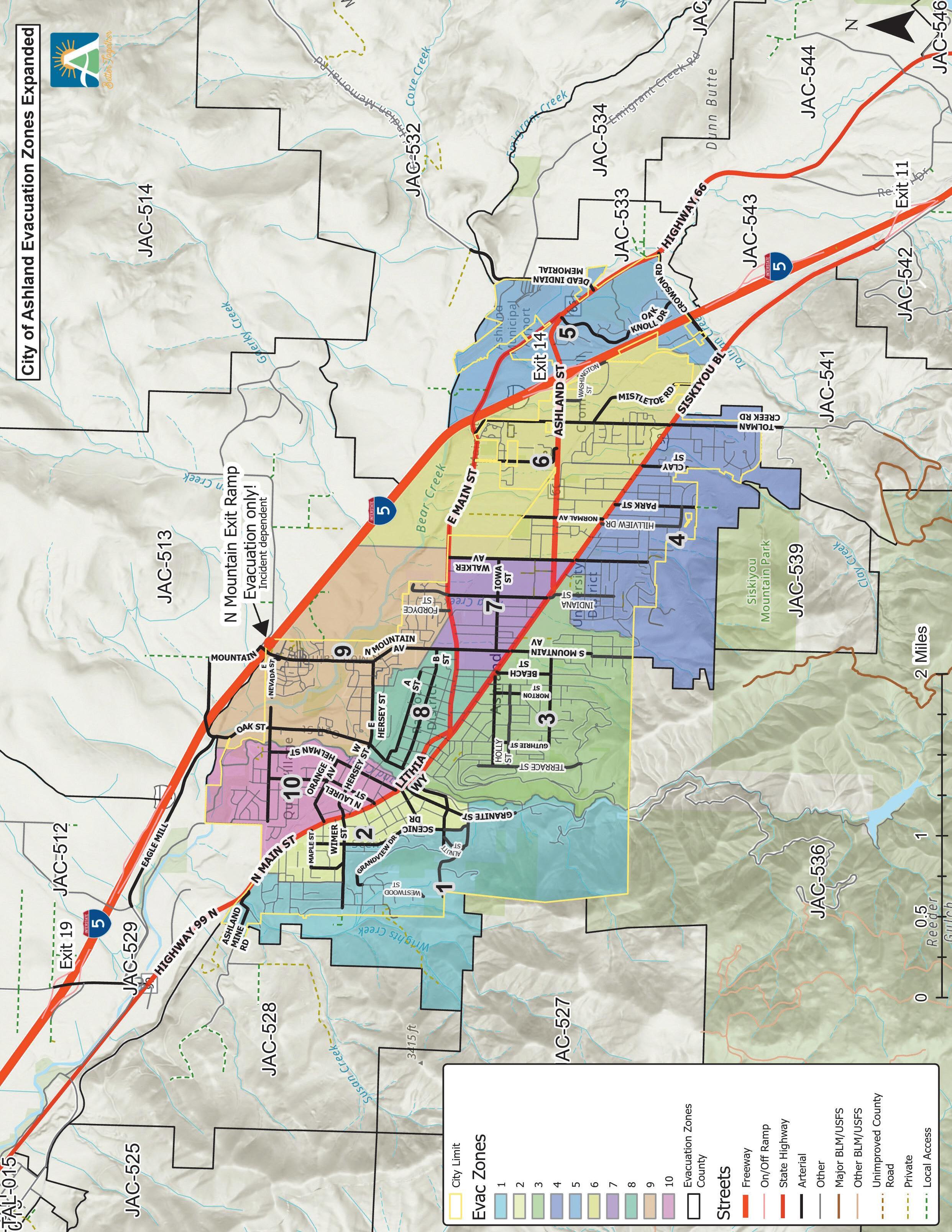
Local, state and federal agencies will coordinate firefighter and police response; it’s up to residents to be prepared and help one another

DBy Sydney Seymour For Ashland.news
espite all hands on deck during the 2020 Almeda Fire, Kelly Burns, Ashland’s emergency preparedness manager and the initial commander of Ashland Fire & Rescue at the time, said, “I felt like I didn’t have a plan.”
Now, agencies across Jackson County go over a shared wildfire evacuation plan that spells out each group’s duties.
Law enforcement leads the way
In the event of a citywide wildfire evacuation, local fire departments and the Oregon Department of Forestry (ODF) will focus on fighting the fire while local law enforcement are tasked with leading the evacuation.
“Communication is key for everybody involved,” Jackson County Sheriff’s public information officer Aaron Lewis said.
When a wildfire is reported to 911, the dispatch center notifies the local and state fire and law enforcement agencies. The first law enforcement officer who can get to the fire and then “intelligently determine what evacuations are needed” — whether it’s the Jackson County sheriff or a rookie officer from Oregon State Police — will determine where and at what level an evacuation is required, Ashland Police Chief Tighe O’Meara said.
As more resources arrive, the decision of who leads the evacuation depends on the fire’s location. Inside city limits, the local police department takes charge while others assist. Outside city limits, leadership falls to the county sheriff’s office.
To lead and coordinate the evacuation, an incident command post is established, where two initial commanders from both fire and law enforcement work in “unified command.” ODF plays a crucial role in determining the course of action.
“We provide as much of our expertise as we can when it comes to fire behavior and where the fire might be going,” Natalie Weber, ODF public information officer, said, “so that our partners can make more informed decisions when it comes to evacuations and what areas need to be evacuated.”
Once law enforcement officials understand the scope of the wildfire, they notify county and city emergency managers of evacuation levels and zones. Then the

Kelly Burns, Ashland’s emergency management coordinator, spoke to about 70 people at a wildfire preparedness event at the Bellview Grange in August 2024. The event was sponsored by Ashland.news, Ashland Together, Ashland CERT and the city of Ashland. — Photo by Bob Palermini | Ashland.news
emergency managers send evacuation notices to the public. Mapping tools such as the Genasys app will show users where evacuations are happening. Law enforcement also drives through the area announcing the emergency evacuation over speakers and door-to-door.
“Fire doesn’t care about borders,” Burns said.
With a recently formed shared template, Burns explained, evacuation notices across Jackson County are consistent and issued in both English and Spanish.
Within the city, law enforcement is also tasked with positioning officers and their equipment between the fire and communities, setting up roadblocks and ensuring home security for evacuated tenants. Only residents with identification are allowed back into evacuated areas.
“There are bad actors,” Burns said. “When an area is under evacuation orders, they try to get in because they know no one will be home.”
To recruit more help from the state, city and nearby areas, initial commanders use a mutual aid dispatch, which “establishes a system for all of the agencies to be at the table and come together for the operational side of things and communication,” Julie Denney, Oregon Department of Transportation public information officer, said.
In addition to providing extra staff for traffic control and closing streets to funnel state highway traffic, the Oregon Department of Transportation (ODOT) controls gateways to the freeway for Ashland, Talent, Phoenix and Medford.
During the Almeda Fire, however, O’Meara, the initial police commander, wasn’t informed about an Interstate 5 shutdown until traffic overwhelmed Ashland. That experience, he said, underscores the importance of deliberate communication with everybody involved in facilitating an evacuation and for every agency to be represented in person at a unified command post.
With typically only three police officers and eight firefighters on duty at a given time for Ashland’s 21,000 residents, emergency responders are stretched thin. “They can’t be everywhere,” Burns said.
When responders are overwhelmed, Ashland’s Community Emergency Response Team is “an organized group of your neighbors that are there to assist in disasters,” CERT volunteer Paul Collins said.
However, “In the end,” O’Meara said, “it’s incumbent on each one of us to have a plan and to be self-sufficient.” He continued, “Nobody from an official capacity is going to be your ‘A’ plan and whisk you away to safety. We will do what we can, but we’re going to be overwhelmed.”
Considering the unrealistic expectation that local services can aid everyone in an evacuation, Burns and O’Meara both called for individuals in Ashland and the surrounding area to take responsibility for their own safety and know what to do in an evacuation.
continued from page 17
What’s coming next for Ashland’s evacuation plans
As part of the final draft of Ashland’s 2025 Community Wildfire Protection Plan, Burns organized an evacuation task force including members from the city’s electric, street, and water departments, Ashland police, Ashland Fire & Rescue and ODOT. Those individuals will not only assist in facilitating an evacuation, but their goal is to plan and problem-solve the best ways to streamline an evacuation.
The city is also collaborating with ODOT for a community evacuation drill on Oct. 11, specifically testing the North Mountain Avenue escape ramp, an evacuation route implemented after the Almeda Fire.
“It’s going to be the first big event,” Burns said, “and a lot of eyes are going to be on us to see how it goes.”
He hopes to hold such drills twice a year to prepare residents and encourage self-reliance during emergencies.
“We have to rely on the public to learn their routes, to be prepared to go, and then to help each other,” he said, “because the enemy we face is too great.”
Additionally, Burns and Jackson County Emergency Manager Shawn Richards are working to identify potential temporary evacuation points, or TEPs — wide-open spaces free of fuel for fires — as a safe backup location for those unable to leave cities.
They eventually hope to identify two TEPs per evacuation zone. For now, however, Burns urges residents to look for nearby wide-open spaces, like parking lots, as potential safe zones.
Email Ashland.news Snowden intern Sydney Seymour at sydneyseymourr@ gmail.com.
Ashland Chamber of Commerce fire information page: bit.ly/ashchamberfireinfo
Ashland Chamber’s emergency preparedness and resilience tool kit: bit.ly/ashchambertoolkit
Business Resiliency Workbook for Smoke Preparedness: bit.ly/businesssmokeplan
Download the Genasys app for a map of emergency notices: protect.genasys.com/download

By Steve Weyer Ashland.news
1 Three preparedness levels for 2-Down (6 words)
7 County-wide notification system that uses email, text and phone (2 words)
9 Wildfire Risk Assessment Program (volunteer group that provides advice to property owners; abbr.)
11 Some fires are ___-caused, e.g., 3-Down, others are started by lightning
12 ___ space (protectable buffer between your structure and the surrounding area)
13 Town damaged during 34-Across; first responders, 9-Across and 29-Down have a lot of training and ___
14 Space between your house and flammable sources; the wider and more debris-free it is, the more 12-Across
16 On fire
17 Color of 3rd preparedness level (1-Across); ___ Flag Warning (high wind/temp danger) issued by 20-Across
18 Capable of igniting and burning
20 Operator of weather.gov (abbr.)
24 Color of 1st preparedness level (1-Across)
25 Starting point of 34-Across; ___.News
29 Team of firefighters
30 Part of FEMA or EMT (abbr.)
32 The sharing of information during a fire or any disaster, e.g., via 7-Across
33 Glowing fire remnant
34 Fire that started on Sept. 8th, 2020 in 25-Across, and quickly spread to 13-Across and 23-Down
Preparedness resource links and more crosswords: Ashland.news > Culture > Crossword solution on Page 19
2 Departure before a fire, often hasty (our town and county have designated zones to keep this orderly)
3 The criminal act of deliberately setting a fire
4 A large and fiercely burning fire
5 Drop the ball (e.g., by not planning ahead)
6 Non-EVs should have a full tank of ___ for 2-Down
8 "This is only a ___", e.g., trial message from 7-Across
9 ___-[19-Down] Interface (area of transition between natural and developed environments)
It's packed for an emergency and grabbed during 2-Down (2 words)
Proactive measures to reduce risk
Opposite of rural
Atmospheric pollution meas.
Freedom from danger
Town damaged during 34-Across; mythical bird rising from the ashes 26 Color of 2nd preparedness level (1-Across) 27 Hot, visible part of a fire
Save from danger
29 Community Emergency Response Team (volunteer group that provides disaster training, information and assistance; abbr.)
Airborne particles from a fire
The fire department encourages everyone to connect with family, friends, and neighbors about evacuation plans. Before you leave with your go bag and pets, take a moment — if it’s safe — to check in on neighbors who might need extra help. This kind of support comes naturally when people know and trust each other.
You can build that trust by starting a neighborhood climate club. Some neighbors are fully prepared for a fast-moving fire, while others may be missing a key step. A simple neighborhood gathering before a fire event can help everyone get on the same page.
The Ashland Climate Collaborative can help you make it happen. We’ll show you how to bring your neighbors together for a fun and useful event focused on fire evacuation.

We recommend using the first half of the gathering for a friendly potluck to build relationships. The rest can include sharing go bag ideas and fire department tips or leading a short discussion.
We have everything you need to get started.This could take just an hour—and it’s time well spent. To get started, text or call our Neighborhood Climate Action Network Coordinator, Jim Hartman, at 541-821-1300, or email Ashland Climate Collaborative Executive Director Erin O’Kelley Muck at erin.muck@ashlandclimate.org.
Submitted by Ashland Climate Collaborative, a 501c3 nonprofit organization dedicated to helping the Ashland community live safely and responsibly in a changing climate. Sign up for the ACC monthly e-newsletter at AshlandClimate.org.
Crossword solution puzzle on page 18










Who: Ashland.news is an independent, professional nonprofit news service supported by and serving residents of Ashland and nearby areas.
What: Ashland.news gathers, verifies and distributes reliable, trustworthy and timely Ashland community news and information via its website and email newsletters.
When: Ashland.news is a website available 24 hours a day, 365 days a year, updated regularly with local news and information. Ashland.news also sends out an email newsletter three times a week with links to stories posted on the website.
Where: Ashland.news is available on your desktop computer, tablet and mobile device. Ashland.news strives to cover the entire Ashland community and nearby areas.
Why: Ashland.news exists to inform the civic dialogue and promote cultural engagement in the hope that will help make it possible for residents of Ashland and adjacent communities to engage in informed conversations and effective collaboration, representing diverse points of view while seeking a common way forward.
How: Ashland.news is a community-supported, nonprofit organization sustained by donors and sponsors.
You: Ashland.news exists to serve the community, and will only exist if the community supports it. We believe quality news and current information should be accessible to everyone. We can only continue to provide this service if those who can support us, do support us. You can go to Ashland.news and make a one-time or ongoing donation, whether of $15 or $20 or $25 per month, that will keep this piece of civic infrastructure a sustainable, ongoing part of the community. That will be up to you.
Ashland.news only exists because of donors like you.

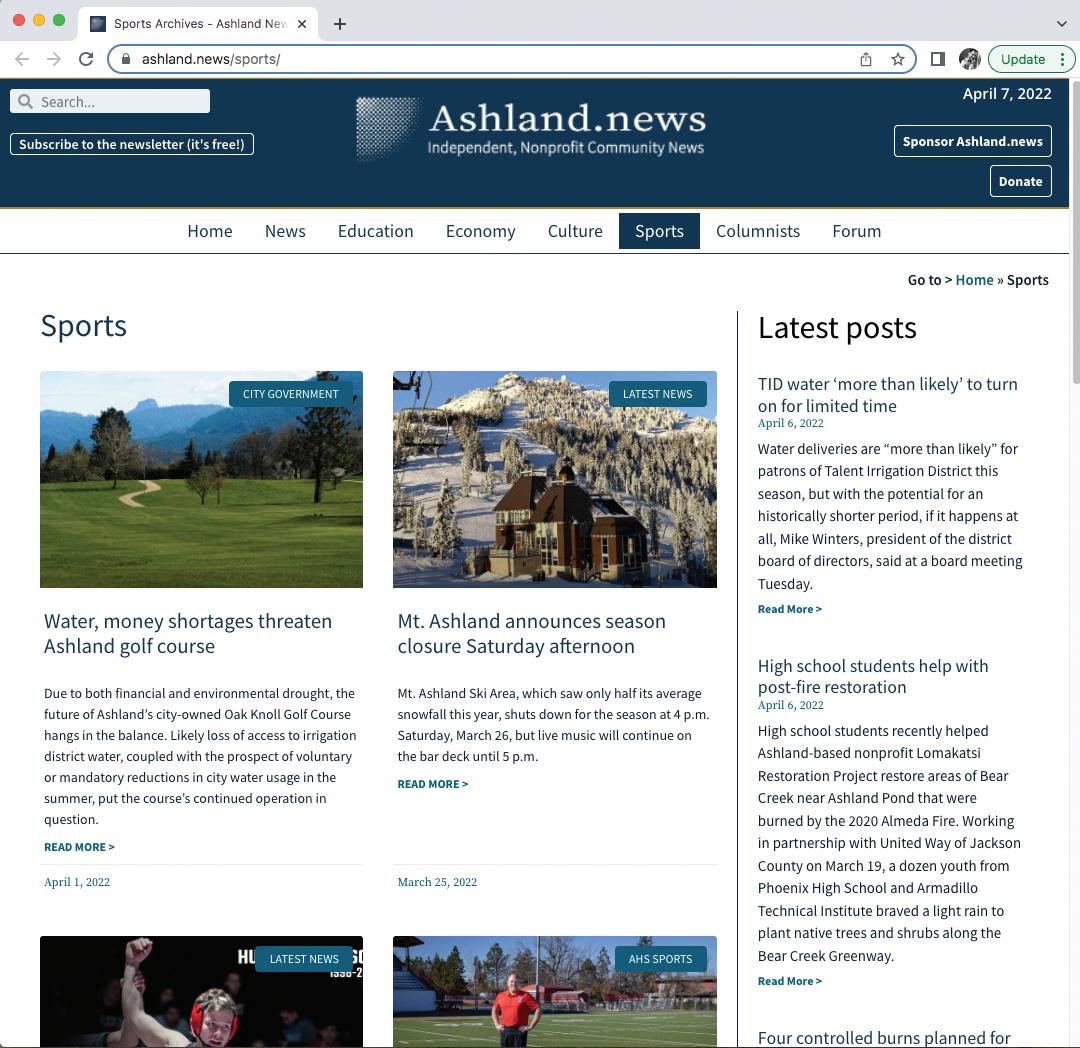
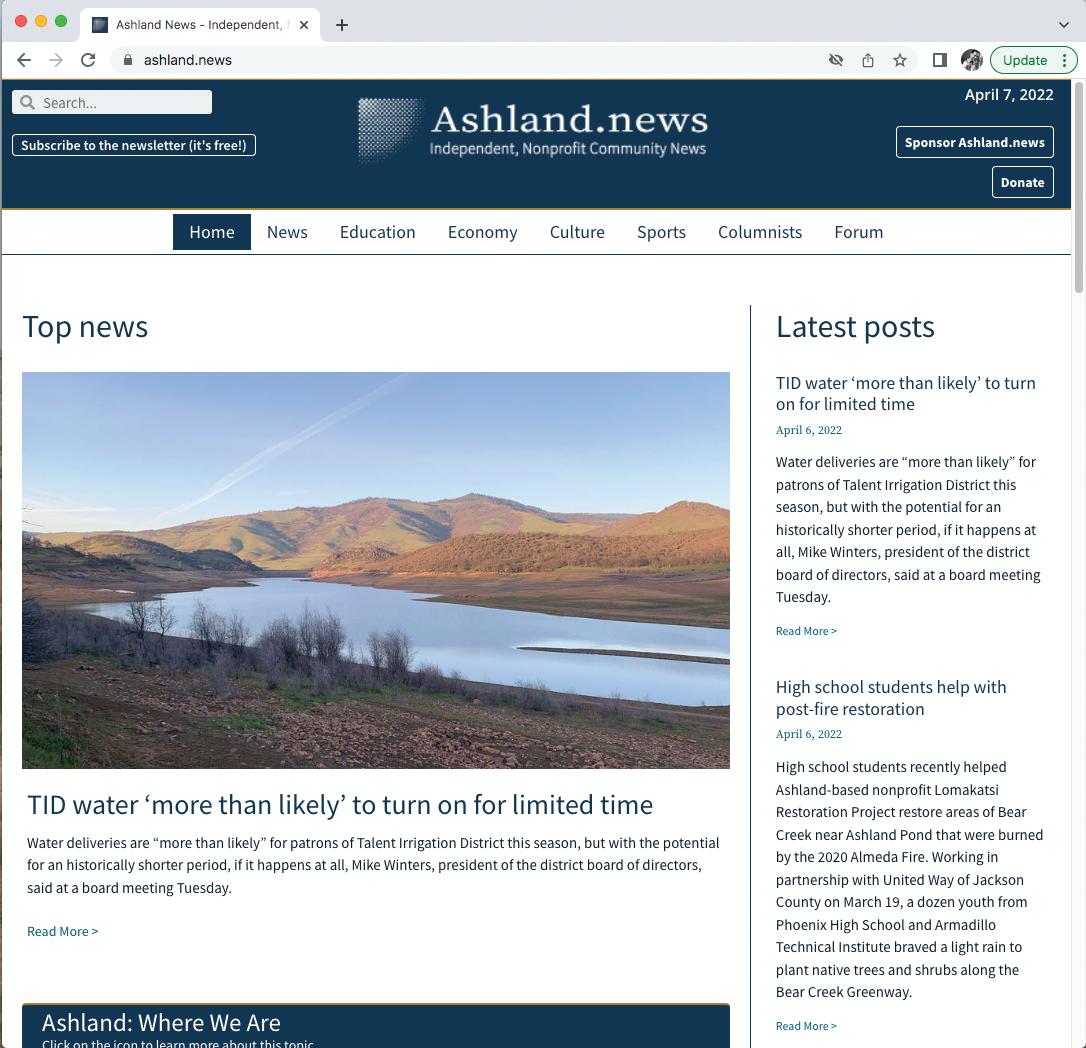



How will you know when it’s time to go? What routes are available to get out of town in an
City of Ashland Emergency Management Coordinator Kelly Burns prepared these answers to questions submitted at the July 16 wildfire preparedness forum.
Q: How will we know which direction (north or south) to evacuate?
A: Local law enforcement and fire officials work together with emergency management to issue real-time evacuation notifications based on fire behavior and road conditions. These notifications will share the location of the fire and the urgency of the need for evacuations. Direction to go will depend on the fire’s location and wind direction.
Q: Will emergency officials give us realtime directions during an evacuation?
A: Jackson Alerts evacuation notifications will share the fire’s location and its direction of travel and other known and verifiable information. Due to the dynamic nature of wind driven wildfires there may not be real-time directions provided. Use Jackson County Alerts, local trusted sources for emergency information (City of Ashland, Ashland Police, Jackson County Sheriff’s Office, Oregon Department of Forestry), Ashland’s Wildfire Hotline (541-5522490, a recorded message that can contain information about fires affecting our region), and local radio (e.g., 1700 AM) for information. It is imperative for anyone living in Ashland and the Rogue Valley to learn their evacuation zones, routes that could be taken in an evacuation, and be familiar with the areas they live in and visit frequently.
Q: What is Ashland’s current evacuation plan?
A: Ashland has 10 evacuation zones and borders many Jackson County evacuation zones. Police officers, both Ashland and other law enforcement agencies, are the primary authority for notifying residents and visitors of the need for evacuations. They do this by identifying areas that will require evacuations and using doorto-door notifications, announcements from their PA systems from their vehicles, establishing road closures for hazardous areas, and utilizing emergency management personnel to send Jackson Alerts evacuation notifications. Ashland
residents are strongly advised to create and practice their own evacuation plans to be better prepared for when an evacuation needs to happen.
Q: What happens if fire surrounds the area or gridlock occurs?
A: If fire surrounds an area or traffic is blocked, residents and visitors would be wise to pre-learn and identify areas in and around town with wide open spaces, clear of vegetation, that could be a temporary refuge from impinging fire. City resources will work to remove blockages in traffic to keep the traffic flow going. Depending on time of day and capacity of resources to get to blockages and remove them, this will be incident and location dependent. It is therefore advisable that people evacuating pre-learn their city and county areas that could provide refuge away from an advancing fire.
Q: Are there emergency backroads or alternate exit routes?
A: There is one additional escape ramp onto I-5 that is located off North Mountain Avenue. This escape ramp could be opened by ODOT during an evacuation, but it would depend on the incident needs. Other routes may exist, such as Eagle Mill Road or Dead Indian Memorial Road, but can be narrow or unmaintained.
Q: Are there plans to improve highway access or reduce choke points (e.g., Exit 19, bridge at 99)?
A: Freeway exits and areas outside of the city of Ashland are not under the authority of the City of Ashland. Jackson County Roads and Oregon Department of Transportation may be working to address this. Within the city, work is ongoing to explore hardening evacuation routes and roadside infrastructure to try to create as much drive-able space as possible on our existing roads.
Q: When and how is the North Mountain emergency I-5 gate opened?
A: This gate is controlled by ODOT in partnership with local Ashland emergency
services and opened only under specific orders, based on the demands of an incident.
Q: Does it allow travel in both directions?
A: It is one-directional, an on-ramp for I-5 and only for emergency use. Specific traffic control by ODOT will determine whether vehicles will be directed to travel south, or re routed onto the north-bound I-5 lanes using a nearby paved passthrough to the northbound lanes.
Q: What should people do if they don’t have a car?
A: Arrange for a ride in advance with friends or neighbors. Individual preparedness and community preparedness is paramount if one does not have a vehicle. Some local efforts are exploring a community-ride share option, but as of July 2025, it does not exist.
Q: Is there a registry for seniors or people with disabilities who may need help evacuating?
A: Ashland seniors can connect in with the Ashland Senior Center for resources available to seniors including evacuation preparedness. There is also the Jackson County Disaster Registry which enters people who may need more assistance into a database for use by emergency responders. It remains an individual’s responsibility to plan for and prepare for evacuations for their own situations.
Q: How are tourists and Spanishspeaking residents being informed?
A: Evacuation alerts will be issued in English and Spanish. For tourists and visitors it is recommended to opt-in to text alerts through Jackson Alerts by texting 97520 to 888777. Once a person leaves the area, they can text STOP to 888777 to stop receiving alerts.
Q: How can we receive accurate alerts if power, cell service, or internet go out?
A: Look for other ways to find accurate information. Ashland has the Wildfire Hotline 541-552-2490 (a recorded line for information on developing and
ongoing incidents), the AM 1700 radio station (a battery powered radio with an AM dial can receive this locally), local public buildings could be used to post information and updates in the event of a complete communications failure (but this would not happen immediately). (Editor’s note: Emergency information is also posted to the Ashland.news website (Ashland.news), Facebook page and X (formerly Twitter) and Bluesky accounts.)
Q: What’s the difference between Nixle and Jackson Alerts? Do both require sign-up?
A: Jackson Alerts is the emergency alerts account for all cities and unincorporated areas of Jackson County. Nixle is a text-messaging utility within Jackson Alerts for specific opt-in text message groups. Signing up for Jackson Alerts requires creating an online account at jacksoncounty.org/alert. Text opt-ins can be achieved by texting any of the words below to 888777: 97520 (text messages include advisories, utility outages, and more serious alerts like evacuations. Best option for visitors of Ashland); WATERSHED (text messages include information about prescribed burns and smoke that impacts our area); or 97520SHELTER (text messages include information about local severe weather shelters, locations, timeframes, and where to look for more information on sheltering).
Q: How do we report overgrown weeds or hazardous grassy areas?
A: Use the Ashland Fire Adapted Communities program via ashland.or.us/ fireadapted or call 541-482-2770.
Q: What should someone do if they need help removing a large tree?
A: Contact local arborists or seek support through Ashland’s Firewise USA neighborhoods or the city’s fuels reduction assistance program.
Q: How can I volunteer?
A: Contact Ashland CERT, Ashland Fire & Rescue, or visit ashland.or.us/volunteer.
Want to know what’s coming next for Ashland.news — before anyone else? Ashland.news donors get early access to exclusive updates, newsroom insights and special event previews through the “Inside Scoop,” a behind-the-scenes newsletter just for supporters.
You can get the Inside Scoop too—while helping sustain our independent, nonprofit, paywall-free journalism. Become a recurring donor today at ashland.news/donation (or point your smartphone at the QR code on this page).
Here are excerpts from a recent edition our donors saw first, weeks ago.

Welcome to our new newsletter, the Inside Scoop. We report so much about the world around us, but we rarely talk about ourselves and the nonprofit local news sector that is emerging in the face of the collapse of traditional media. We’ve created the Inside Scoop to keep our supporters in the loop with inside track information.
Whether you’re on staff or volunteering, you’re a monthly sustainer, or you have provided a major gift, we appreciate you! You have helped to make Ashland.news what it is today—one of Southern Oregon’s premier digital news sources, with more than 5,500 subscribers, and a mind-boggling 50,000 visitors to our website in an average month.
Moving forward, we hope to continue to grow our “family” by reaching more people, growing our staff to produce more great journalism, and ensuring that Ashland.news is here to stay — because it’s just that important. Thanks for being on this journey with us!
After two and a half years of service as president of the Ashland.news board of directors, Paul Steinle has passed the torch to Lorrie Kaplan. Lorrie has served on the board since its formation in fall 2021, following a career in nonprofit leadership. (You can read more about Lorrie at ashland.news/ board-members/.)
“We’re very grateful to Paul for his dedicated service to Ashland.news,” says Lorrie. “I’m proud to follow in his footsteps as well as those of Herb Rothschild, whose vision, leadership, and community knowledge helped bring Ashland. news into being. The good news is that Paul and Herb will continue to be a part of the overall Ashland.news team.”
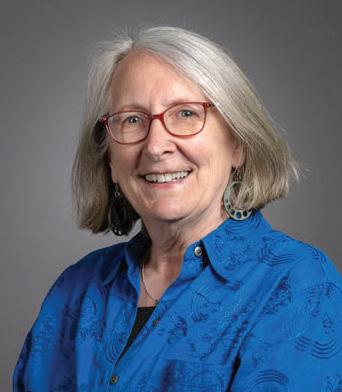
“I am passionate about ensuring that our great work endures well into the future, and continues to expand and grow,” Lorrie adds. “Professional nonpartisan local news is essential for the health and resilience of our community. Long live Ashland.news!”
Lorrie welcomes the opportunity to chat over coffee. Feel free to email her at lorriekaplan@gmail.com or call 240-676-0040.
In spring 2021, a handful of concerned Ashland residents initiated a plan to create a reliable news service for our community. We needed this because our legacy newspaper, The Daily Tidings – founded in 1876 – had gone out of business. On Jan. 14, 2022, the Ashland.news website was born.
Since the beginning, our digital community news service has been delivered free to anyone who wishes to visit the Ashland.news website or to subscribe to our three-times-aweek e-newsletter. Now, in 2025, we have 5,500-plus e-news subscribers, and we’re still growing.

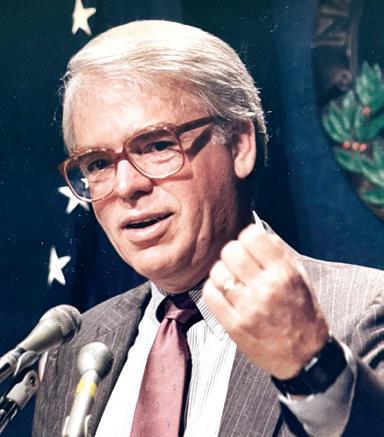
Our goal was to assemble a professional, full-time reporting staff complemented by seasoned freelancers to produce an accurate flow of news and information about our community.
We started with a veteran editor, Bert Etling. He hired two trained reporters and found a dozen or so experienced freelancers who have demonstrated their competence to fulfill this goal. We created a website – Ashland.news – as a repository for all our reporting and began delivering digital newsletters, three times a week, to anyone who wanted accurate news about Ashland.
Using this approach, we’ve built a digital news and information service that seeks to fulfill an ambitious goal: “Connecting Ashland Through Trustworthy Journalism.”
The final and most enduring ingredient needed for the success of this enterprise has been the 1,200 or so who have supported Ashland.news with annual donations or monthly contributions as Ashland.news “sustainers” (making ongoing monthly donations).
Please continue this personal investment you have made to enable Ashland.news to fulfill its mission. We need you to maintain your generous support as the years go by to maintain Ashland.news.
Ashland.news is thrilled to announce that, effective June 1 through the end of the year, David Sommers is serving as interim executive director on a short-term, part-time consultant basis.
David brings more than 20 years of leadership experience across journalism, government, corporate and philanthropic sectors. Most recently, he served as the inaugural publisher of the Rogue Valley Times and chief revenue officer of EO Media Group.
David joined the Ashland.news board in January. David will focus on strengthening our development strategy and internal operations, hopefully paving the way for hiring a full-time, permanent executive director.

David’s role does not include oversight or decision-making on editorial matters. Connect with David at dsommers@ashland.news or 213-453-6446.
Burns echoed her advice: Just get started where you are.
“Throw a few things into an available bag or sack and put it by your door and that’s the beginning of your go bag,” he said. “It will actually make you feel better and it will reduce some of the stress you feel when we get inundated with smoke … you’ll at least have a start.
“If everyone did anything after this talk tonight besides going home and maybe feeling a little better, I want you to make a plan for Level 1, make a plan for Level 2 and make a plan for Level 3, and if they’re the same, great,” he said. “But each one requires some thought, and potentially some action.”
Burns directed individuals to think about evacuation paths both north and south — and east, as well, toward Klamath County.
“I need you to learn your town,” Burns said, noting it’s important to find open spaces where you can “hole up” during a fire if evacuation routes are blocked.
Sydoriak, who’s been a wildfire evacuee herself, reminded the audience that, through her experience, she learned there’s even more to prepare beyond the go bag.
“No matter how we prepare — go bags, kits, know our route, etc., evacuations are difficult,” Sydoriak said. “And I suspect with climate change and the repeated disasters that we are facing that we will all of us at one point or another have to evacuate … it’s a very traumatic experience, so how do you prepare in other ways than the go bag?”
Sydoriak evacuated from wildfire more than 20 years ago in New Mexico.
There was no 1-2-3, ready, set, go system in place in New Mexico some two decades ago, she said.
Instead, Sydoriak had to realize on her own it was time to tell her husband to pack up their eight pets and then-12year-old daughter and leave their home.
“As the fire roared into town, people had 15 minutes to go,” she said. “That could’ve been prevented by the system that we now have in place.
“There were no cell phones in those days; we had to find shelter.”
‘Preparedness is a process’
Emergency managers do their best to try to prepare individuals for the worst, but Sydoriak emphasized there are things they can’t help with.
“You have to have a plan,” Sydoriak said.
“Preparedness is a process. It’s not done because you put your go bag by the door and put a few things in there. My goal is to raise your awareness of evacuation challenges, help you become more self-reliant in making those decisions, and helping your community out by caring about other people during an evacuation event.”
Asked how many in the audience had experienced evacuation, about 3 to 4% of the crowd raised their hands.
She also asked what was the one of the more difficult aspects of evacuation.
“Traffic,” noted multiple people in the audience.
“How many of you have thought about what’s going to happen if there’s no internet and the satellite goes down?” she asked.
“Asking what-if questions today could save you tomorrow,” she added.
‘Run through all the what-if scenarios’
O’Meara, the police chief, echoed Sydoriak and Burns in regards to evacuation planning.
“A lot of this evacuation topic is just dependent on the situation,” he said. “During Almeda, we had a traffic nightmare.”
Each person is encouraged in an evacuation situation to take their own initiative, to be responsible for themselves, he added.
“Run through all the what-if scenarios,” O’Meara said.
He also noted that while there were more than 10 Ashland police officers on duty during the Almeda Fire, that numbers are dependent on the time of day a disaster occurs. If in the middle of the night, numbers on patrol could be much fewer.
Paul Collins, volunteer deputy of Ashland CERT (Community Emergency Response Team), spoke with Ashlanders about what the organization does to help communities prepare for natural disasters. He’s served with CERT for about 18 years.
“CERT is an organized group of your neighbors that are there to assist in disasters where we don’t have enough emergency responders to go around,” Collins said. “And we assist the fire departments in small ways and we help the community learn about prevention.
“I want to make sure that people can get information about CERT and our upcoming fall (basic training) on Sept. 26,” he added.
The training, scheduled from 5:30 to 8:30 p.m. at SOU’s Lithia Motors Pavilion, is free to Rogue Valley residents. Residents can learn how to prepare to help themselves and others during various natural disasters, including wildfires.
In other planned events, Burns shared about working with community partners to host a community wildfire evacuation drill from 9:30 a.m. to 11:30 a.m. Saturday, Oct. 11, to get residents ready for the real thing.
“This will be an actual practice drill

and I’ve got a lot of community partners and agencies that are willing to step in and help pull this off,” he said.
Registration will open in September with more information available closer to that time.
Spreading the get-ready gospel
In 2024, Ashland.news formed an informal community partnership to combine skills and resources with multiple partners, including Ashland Climate Collaborative, Ashland Together and the city of Ashland, to create a series of community events.
Ashland.news will publish a special print Wildfire-focused edition tentatively in coming weeks.
“In addition to reporting the news, we also believe we have an important role to play as a neutral convener of important community conversations,” said Lorrie Kaplan, president of the Ashland.news board of directors.
“When I think about issues that we need to be informed on … this issue is of course top of mind for all of us.”
Reach Ashland.news reporter Holly Dillemuth at hollyd@ashland.news


O’Meara emphasized it’s important not to wait for a firefighter or law enforcement officer to bang on your door to leave the area if needed, even if it’s in the middle of the night.
“We just don’t have that many people to do it,” he said.
Learn more about CERT
Representatives from numerous agencies were also on hand following the event to answer more questions and distribute resources.








